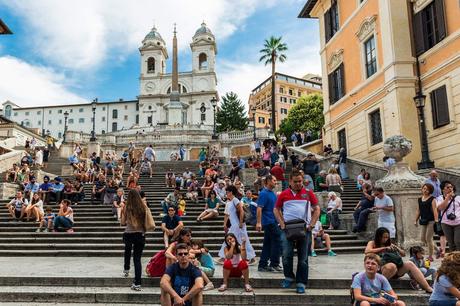Centrally located in the city of Rome, the Spanish Steps have become one of the must-see attractions for your next Italy vacation. Made doubly famous by the fact that it made a feature as the backdrop in the 1950’s by the iconic film ‘Roman Holiday’ which featured Audrey Hepburn and Gregory Pick, the history of the Spanish Steps truthfully begins in 1723 when it was brought to life by Etienne Gueffier. The beauty of the staircase has lived on as a Roman meeting place for artists and poets who were inspired to draw its likeness time and time again.
Why were the Spanish Steps built?
Contrary to the name, it was the French who financed the Spanish Steps to symbolise the alliance between Spain and France. The initial plan was to connect the French Church Trinita dei Monti which sat at the very top of where the staircase was planned to go, to the Spanish Square below. After a century of disagreements by the King of France and the Pope, a final decision was made by Pope Innocent XIII in 1717. The design was to be created by lesser known architect Francesco de Sanctis who had won a competition to design the façade of the Spanish Steps and two years later it was finished.
After its construction, artists and poets alike flocked to the staircase to draw inspiration from its butterfly-shaped elegant design. With this came an influx of models who would try their best to be chosen as a muse, and so forth the Spanish Steps became a meeting place, a social setting where people watching was common and relaxing by enjoying the views below are still conducted by tourists today.
What to see
Arguably the best time to see the Spanish Steps is in the season of Spring, where brightly coloured flowers line the staircase, a homage to Francesco de Sanctis’s original design. Towards the base of the steps you will find the final residence of English Romantic poets John Keats and Shelley, a home that has now been transformed into a celebration of the work and life at the Keats- Shelley museum.
You will also come upon the Fontana della Barcaccia, a 17th century baroque style fountain that features an old sunken boat display that it said to symbolise an old legend that dates back to the Great Flood of Rome centuries earlier. It is the work of Pietro Bernini and was finished by his son Gian Lorenzo, a famed architect who went on to design many other squares and churches in Rome.
Where to eat nearby
Don’t be fooled by the high-priced restaurants near the Spanish Steps that are filled to the brimmed with people. This isn’t a true indicator of the quality of food as the prices are higher due to its prized location. Try the Palatium- a 5-minute walk from the Spanish Steps- a less congested eaterie that doesn’t hold back on amazing food. The menu changes regularly and all the food is locally produced in the Lazio region. Afterwards if you’re wanting for something sweet, head to Pompi. The self-acclaimed King of Tiramisu offers the traditional Italian dessert in all its classic flavours, and then some different options like strawberry and banana.
Advertisements

